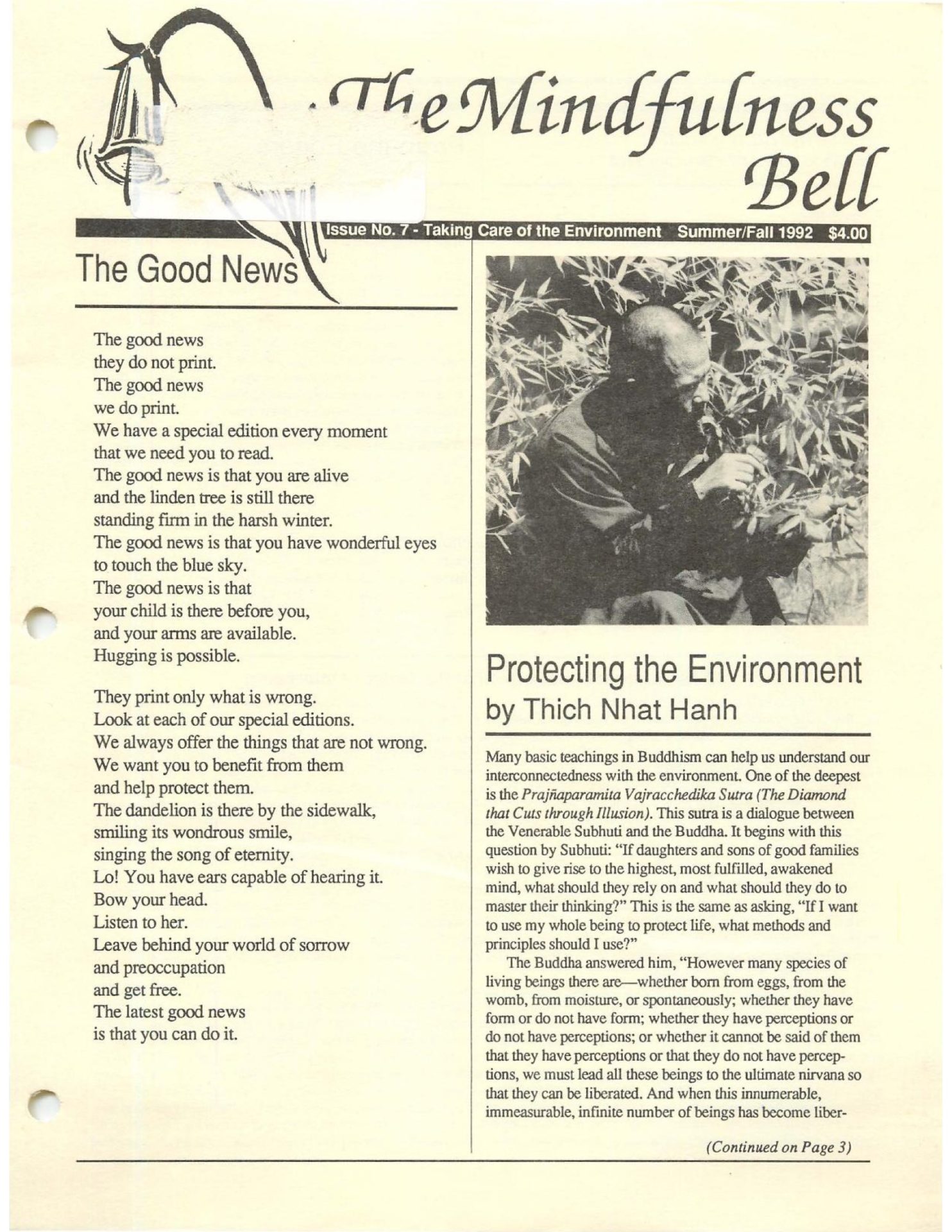By Mitchell Thomashow
As an educator, I work with adults who are studying to become environmental professionals, including those who have made this career decision at an early age and mid-career adults dramatically changing their professional and personal lives. Whatever the depth of awareness of this career decision, most aspiring environmentalists perceive themselves as choosing more than a profession—they are searching to link their personal identity to an environmental way of life. Their environmentalism is, in fact, intrinsic to their personal identity.
By Mitchell Thomashow
As an educator, I work with adults who are studying to become environmental professionals, including those who have made this career decision at an early age and mid-career adults dramatically changing their professional and personal lives. Whatever the depth of awareness of this career decision, most aspiring environmentalists perceive themselves as choosing more than a profession—they are searching to link their personal identity to an environmental way of life. Their environmentalism is, in fact, intrinsic to their personal identity.
Through a variety of techniques, I try to instill in them the importance of self-reflection and clear attentiveness to their own environmental identity development, which includes their developmental relationship with nature. Such themes as wilderness experiences, relationships to other species, relationship to material life, and sense of place might be the stage through which an individual develops changing concepts of self and works out critical lifecycle decisions. Our relationship to nature is inextricably linked to cycles of ego development. During various stages of our life we conceive of nature differently. What is a secret space for a child becomes a sacred space for the adult. Mountains, landscapes, gardens, cities, our fields of experience are regarded differently depending on the lifecycle changes we confront. This is understood by educators, who observe the subtleties of environmental identity as they're manifested in children, adolescents, adults, seniors, etc. It is recognized by psychologists who describe the symbolic, unconscious function of environmental experiences.
I have developed a curriculum during which students seem to undergo a distinct sequence of emotional stages: (1) Affirmation and Support, (2) Anxiety, Despair, Blame, and Guilt, and (3) Meaning, Responsibility, and Action. We explore these through "environmental meditations" that use the natural environment, for example habitats, weather, or biogeography, as a bridge to meditative awareness. Students can do these alone or in a group, sitting, standing, walking, or lying down. Here is an example—a "yin-yang meditation." The students find a deep, dark, earthy, enclosed spot, and focus entirely on the elements of that place—wind, sound, smell, texture, moisture. Then they do the same in a prominent, exposed, sky-view spot. It is important to let students know that these exercises are not threatening, since many people have no previous experience of meditation. Following meditation, observation, and hiking, the group reconvenes to discuss their experiences. I often ask them to consider how we can develop routines and rituals that can incorporate such meditative outdoor experiences into their environmental practice.
We also study resource transformation as another way of studying ourselves. I ask students to examine the ecological-economic pathway of every day commodities. Holding up a magic marker, for example, I give the students a sheet of blank newsprint on which to draw a diagram outlining everything they know about the production, distribution, and consumption of magic markers. Typically, their papers remain blank. They have virtually no knowledge about this commodity—how it is produced, whether its use entails environmental pollution, or whether it raises any other political issues such as the quality of the work environment, etc. Then we repeat the exercise using a piece of toast. Where does the bread come from? What about the toaster oven? I examine its style and consider its consumer accoutrements. I note that it is plugged into a complex network of wires and energy. I ask the students if they can trace the process by which bread becomes toast.
As a follow-up assignment, I ask them to consider a tool of the information age. After describing all the benefits and pleasures they derive from this tool, they are instructed to learn as much as they can about its production and derivation. In effect, they are asked to be mindful about the use of this tool. Where does it come from? Why do they use it? What purpose does it serve? What are the ramifications of its use?
In a world filled with promises of endless consumer wealth, we are perennially tempted with the fruits of material affluence. If our culture teaches us anything, it is how to use commodities as symbols of personal development. Merely flip through the advertisements in any magazine, even Sierra Magazine, where countless pages are filled with the goods of environmental consumerism. Here we find an environmental style, a stereotypical character who dresses in natural fabrics, enjoys rugged good looks, drives a Volvo, and adores compact binoculars and cameras.
Few of us are immune to the relentless pressure to define ourselves through our commodities. Whether through our clothes, our car, our computer, or even our wilderness equipment, we face a persistent struggle: how do we separate legitimate interests, joys, and curiosities from the traps of style, image, and consumer addiction? This question is fundamental to environmental identity. "Ultimately," we must ask ourselves, "how do we wish to live?"
We really cannot answer this question without direct knowledge of where things come from. Outside Magazine may help us choose the best mountain bike. It may even tell us about the ecological impact of these bikes. But it is unlikely to provide a taxonomy of the natural resource transformation process that yields the bicycle. In other words, we are infrequently exposed to the ground floor of material life, the economic and ecological basis of commodity production. In most cases, we just don't know where the products of our everyday lives come from .
Environmental identity is formed not only on the basis of our aesthetic and spiritual connection to the natural world, but also out of our understanding of the processes of natural resource transformation. Our participation in material production, our relationship to technology, and our awareness of environmental pollution all have cognitive, effective, and symbolic connotation. To describe a natural resource is to consider a potential. The eastern white pine may be a ship's mast, the floor of a house, an ornament, a shrine, or a weed. It depends on who you are, when and where you lived, and to what culture you belong.
We live in a world of families, children, and jobs, as well as countless accoutrements and necessities-automobiles, money, rent, mortgage, and appliances. We may dwell for hours in the texts of environmental philosophy only to return to the demands of our children. Environmental responsibility is something that happens all the time. From disposable diapers to global warming, our action is always needed, our mindfulness essential. Sometimes we succeed in living by our principles. Sometimes we fail, and can only remind ourselves to do better the next time.
Environmental identity is lodged in the real circumstances, events, and habitats of everyday life. The task for the educator is to present students with a process that enables them to integrate these experiences. "Sense of place" is a concept around which such integration occurs. Sense of place is the domestic basis of environmentalism and the source of our deepest connection to the natural world. I ask the students to describe (metaphorically or literally) both their formative environmental experiences and their ideals and wishes for the future. Through this process of self-reflection they come to understand their own sense of place, people, community, land, and species that form their networks of domesticity and exploration, the sources of their sustenance and struggle.
This exercise of developing a "sense of place map" allows students to create a geography of their environmental identity. Real places take on new meaning. They become good, wild, and sacred, as Gary Snyder describes. Students rediscover their sources of inspiration, their blocks to awareness, their totems. They review the patterns of their lives. They assert what is important for them, visually recreating many of their most meaningful experiences. In some cases, they recognize how difficult it is to establish meaningful community and how sense of place is so easily eroded, how sacred places become wounded. They recall special places from their past that no longer exist, although they still reside as internal sanctuaries, that offer them important stories and lessons. And they discover the links between personal development and natural places, out of which they formulate environmental identity.
The various distractions of everyday life—the conflicting impulses that drive our energy, the struggle of living in a culture that devalues nature—make it difficult and rare to discuss such seemingly impractical ideas as environmental identity. But such discourse is an opportunity to integrate theory and practice and gain a deeper awareness. I call this approach "mystical ecology" because it represents the use of the natural environment as a bridge to meditative awareness. "Mystical" connotes wonder, awe, and transcendence, and "ecology" connotes life, energy, and interconnectedness.
Mitchell Thomashow, Co-Chair of Environmental Studies at Antioch College/New England, attended Thay's 1991 retreat for environmentalists. A copy of a longer version of this article appeared in Trumpeter, Summer 1991.

